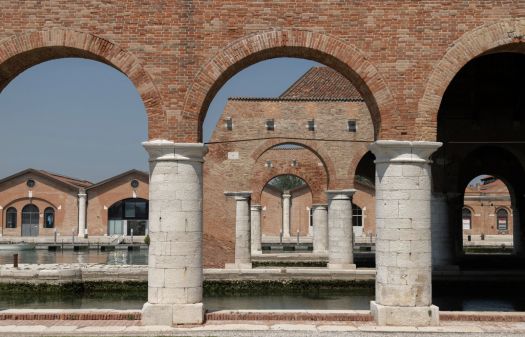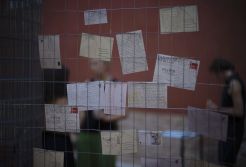Aur Bleddyn talks about her rewarding Fellowship experience
9 June 2025
MA Contemporary Curating student has been awarded the British Council's Venice Fellowships…
Manchester School of Art is a partner institution in the British Council’s Venice Fellowships programme. This distinctive Fellowships opportunity offers the Fellows to have the chance to conduct their independent research in and around Venice. A key part of British Council’s presence in Venice, the Fellowships Programme offers a unique opportunity for emerging creatives and future leaders to represent the UK on an international level whilst broadening their perspective, making connections and developing their creative practice.
The Venice Fellowships programme is a unique opportunity for students to spend a month to fulfil their international ambitions in developing their practice and curatorial skills internationally in Venice during the world’s most important art event. The Fellowship also aims to support students to explore how to work internationally while providing them with a platform to engage with the Venice Biennale to research and develop new connections with curators, critics, artists, and professionals working cross the UK and internationally.

Could you please tell us about yourself and your experience with your academic studies on the MA Contemporary Curating programme at Manchester School of Art?
I’m from Llanbrynmair, a small village in Mid Wales, and I began my studies in Fine Art at Edinburgh College of Art. Motivated by a strong connection to Welsh identity in my practice, I shifted focus to Welsh history and literature, studying Philosophy and Welsh at Cardiff University. This interdisciplinary approach culminated in a thesis exploring art as a means of recalling cultural memory in Wales.
After completing my BA, I spent a year gaining practical experience in the Welsh art scene. I curated exhibitions with students and emerging artists at Cardiff MADE, contributed to public programming for Artes Mundi’s biennial international art prize and supported major Welsh exhibitions as a visual arts assistant at Aberystwyth Arts Centre. These experiences sparked a deeper interest in curating, particularly in amplifying Welsh art and identity.
Through the MA Contemporary Curating programme at Manchester School of Art, I’ve expanded my understanding of curatorial theory and practice, engaging with guest curators, visiting exhibitions, and building confidence in my own curatorial voice. My research focus during the MA has explored postcolonial discourse and collective curatorial strategies. This has led to a curatorial placement with Factory International and, most recently, a fellowship at the Venice Biennale.
Candidates are selected through a competitive application process… So, can you tell us about your research project and what motivated you to apply to this specific international Fellowship?
My curatorial research focuses on national identity, with particular attention to Welsh identity. Notably, Wales has never had its own architecture pavilion at the Venice Biennale. This absence motivated me to explore what a Welsh contribution could look like, in response to the Biennale’s theme of intelligence: collective, natural, artificial.
My proposed project centred on the Welsh vernacular tradition of Tŷ Unnos, a form of architecture rooted in communal action, temporality, and resistance. I approached this tradition as a curatorial method to explore collective intelligence through site-specific research. Engaging with locals, international visitors, and fellow participants, I intended to be collected cross-cultural oral histories—preserving sensory traditions, fables, and recipes, within a “site-less” Tŷ Unnos. The aim was to metaphorically turn the house inside out, culminating in a publication that captured this shared intelligence.
During my time in Venice, I was fortunate to build a strong network of local residents who supported me in realising a one-night event shaped by my research. Given the original function of the Tŷ Unnos, as an act of resistance to housing precarity, the project evolved to explore local strategies of resilience in Venice. I invited residents to collaboratively construct a Tŷ Unnos, where each participant contributed a postcard offering a personal solution to the challenges of daily life on the island. These contributions formed a collective house of resistance, reflecting both the spirit of the original Welsh tradition and the contemporary realities of Venice.

What are the benefits of spending a month in Venice during the world’s most important art event?
Spending a month in Venice during the Biennale was more valuable than I could have anticipated. I hoped to gain deeper insight into how different nations represent themselves through art, and how curators make critical decisions in selecting and presenting work. Being immersed in the Biennale allowed me to closely observe a wide range of curatorial approaches, how they responded to the thematic brief and addressed contemporary issues from diverse cultural perspectives. Being in Venice for a month allowed me to revisit pavilions multiple times, reflecting on the work and how various audiences responded.
What you hoped to achieve through this unique fellowship opportunity?
Beyond the pavilions, the Fellowship also gave me time to consider the Biennale’s presence within the city itself. I was able to reflect on how an event of this scale interacts with its local context. This critical awareness of the Biennale’s impact on Venice’s residents became an important part of my curatorial thinking, influencing how I approached my own project and research. Ultimately, I hoped this Fellowship would allow me to experience firsthand how curating operates at a global level, while remaining considerate to the local realities in which it takes place.
Has there been a formative and inspirational experience? Also, how has this impacted on your curatorial thinking?
Without a doubt, this has been a formative experience. As my first international fellowship, it challenged me to reflect on the social impact of my work, the purpose behind my practice, and how to engage meaningfully with participants and audiences.
Venice itself was a source of inspiration. The city’s resilience, both environmentally and socially, offers important lessons in how communities adapt and persist in the face of global and local challenges. That spirit of resistance resonated strongly with my curatorial research and added a new dimension to my understanding of place and cultural identity.
The Biennale was, in many ways, a living library of curatorial practice. Having direct access to such a range of exhibitions and national pavilions expanded my awareness of how different countries engage with curating. I was particularly inspired by the British Pavilion’s co-curation with Nairobi, Ireland’s Assembly Pavilion with its multidisciplinary community contributions, and Australia’s Home Pavilion, which was supported by a strong public programme. As I continue to develop my research around collective and postcolonial methods, these experiences will remain central to how I imagine and shape future projects.



